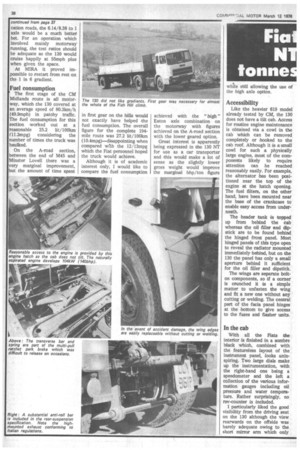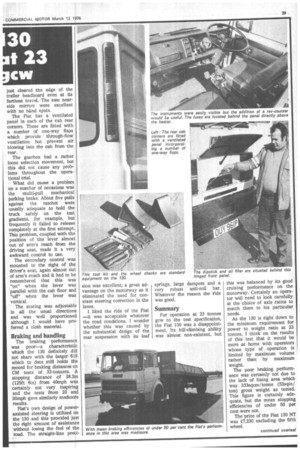Accessibility
Page 58

Page 61

If you've noticed an error in this article please click here to report it so we can fix it.
Like the heavier 619 model already tested by CM, the 130 does not have a tilt cab. Access for routine engine maintenance is obtained via a cowl in the cab which can be removed completely or hooked to the cab roof. Although it is a small coWl for such a physically large engine, most of the components likely to require attention can be reached reasonably easily. For example, the alternator has been positioned near the top of the engine at the hatch opening. The fuel filters, on the other hand, have been mounted near the base of the crankcase to enable easy access from underneath.
The header tank is topped up from behind the cab whereas the oil filler and dipstick are to be found behind the hinged front panel. Most hinged panels of this type open to reveal the radiator mounted immediately behind, but on the 130 the panel has only a small aperture behind it sufficient for the oil filler and dipstick.
The wings are separate bolton components, so if a corner is crunched it is a simple matter to unfasten the wing and fit a new one without any cutting or welding. The central part of the facia panel hinges at the bottom to give access to the .fuses and flasher units.
In the cab
With all the Fiats the interior is finished in a sombre black .which, combined with the featureless layout of the instrument panel, looks uninspiring. Two large dials make up the instrumentation, with the right-hand one being a speedometer and the left a collection of the various information gauges including oil pressure and water temperature. Rather surprisingly, no rev-counter is _included.
I particularly liked the good visibility from the driving seat on the 130 although the view rearwards on the offside was barely adequate owing to the short mirror arm which only just cleared the edge of the trailer headboard even at its farthest travel. The two nearside mirrors were excellent with no blind spots.
The Fiat has a ventilated panel in each of the cab rear corners. These are fitted with a number of one-way flaps which provide through-flow ventilation but prevent air blowing into the cab from the rear.
The gearbox had a rather loose selection movement, but this did not cause any problems throughout the operational trial.
What did .cause a problem on a number of occasions was the multi-pull mechanical parking brake. About five pulls against the ratchet were usually adequate to hold the truck safely on the test gradients, for example, but frequently tit failed to release completely at the first attempt. This problem, coupled with the position of the lever almost out of arm's reach from the driving seat, made it a very awkward control to use.
The secondary control was mounted to the right of the driver's seat, again almost out of arm's reach and it had to be remembered that this was "on" -when the lever was parallel with the cab floor and "off" when the lever waS vertical.
The seating was adjustable in all the usual directions and was well proportioned although I would have preferred a cloth material.
Braking and handling
The braking performan e was poor—a characteristic Which the 130 definitely did not share with the larger 619 which to date still holds the record for braking distances on CM tests of 32-tonners. A stopping distance of 38.2in (125ft 6in) from 40mph was certainly not very inspiring and the tests from 20 and 30mph gave similarly mediocre results.
Flat's own design of powerassisted steering is utilised on the 130 and this provided just the right amount of assistance without losing the feel of the road. The straight,line prat" sion was excellent; a great advantage on the motorway as it eliminated the need for constant steering correction in the lanes.
I liked the ride of the Fiat —it was acceptable whatever the road conditions. I wander whether this was caused by the substantial design of the rear suspension with its leaf springs, large dampers and a very robust anti-roll bar. Whatever the reason the ride was good.
Summary
For operation at 23 tonnes gcw to the test specification, the Fiat 130 was a disappointment. Its -hill-climbing ability was almost non-existent, but this was balanced by its good cruising performance on the motorway. Certainly an operator 'will need to look carefully at the choice of axle ratios to match them to his particular needs.
As the 130 is right down to the minimum requirement for power to weight ratio at 23 tonnes, I think on the results of this test that it would be more at home with operators whose type of operation is limited by maximum volume rather than by maximum weight.
The poor braking performance was certainly not due to the lack of lining area which was 333sqam/tonne (53sqin/ ton) gross weight as tested. This figure is certainly adequate, but the mean stopping efficiencies of under 50 per cent were not.
The price of the Fiat 130 NT was £7,230 excluding the fifth wheel.
















































































































